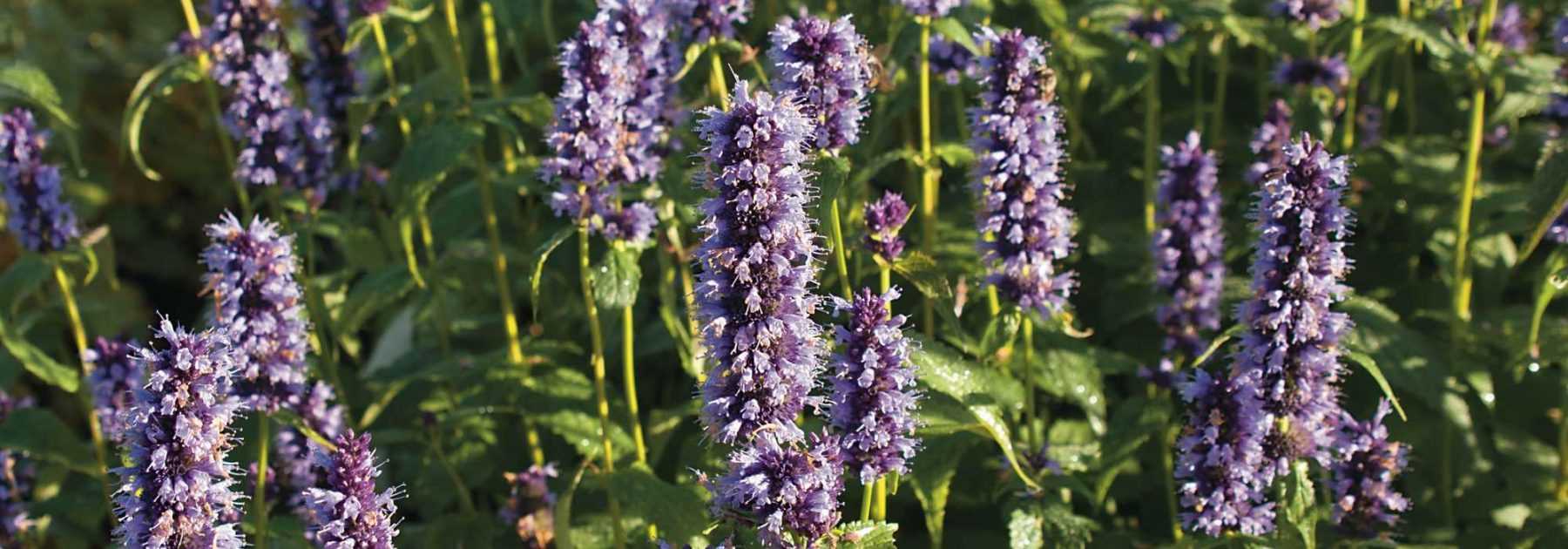
Agastache: Planting, Growing and Caring
Contents
Agastache in a nutshell
- Agastache is a delightful perennial with summer flowering
- Its highly nectar-rich blooms resemble those of lavender
- Very aromatic, its foliage releases a sweet aniseed fragrance
- This is a low-maintenance and easy-going plant
- Its slightly wild appearance works wonders in natural gardens
Our expert's word
Agastache is a delightful perennial, reminiscent of lavender, with its lovely bushy habit and spiked blooms. Highly aromatic, the species Agastache foeniculum is as cherished in the garden as it is in the kitchen. Its aniseed fragrance even earns it the nickname anise hyssop. Agastache rugosa, or Korean mint, is also among the best-known varieties, with its minty scent. Its slightly wild appearance works wonders in natural gardens.
Highly nectar-rich, agastache spikes attract numerous pollinating insects. A valuable ally in the vegetable patch and for biodiversity in all our gardens—even urban ones!
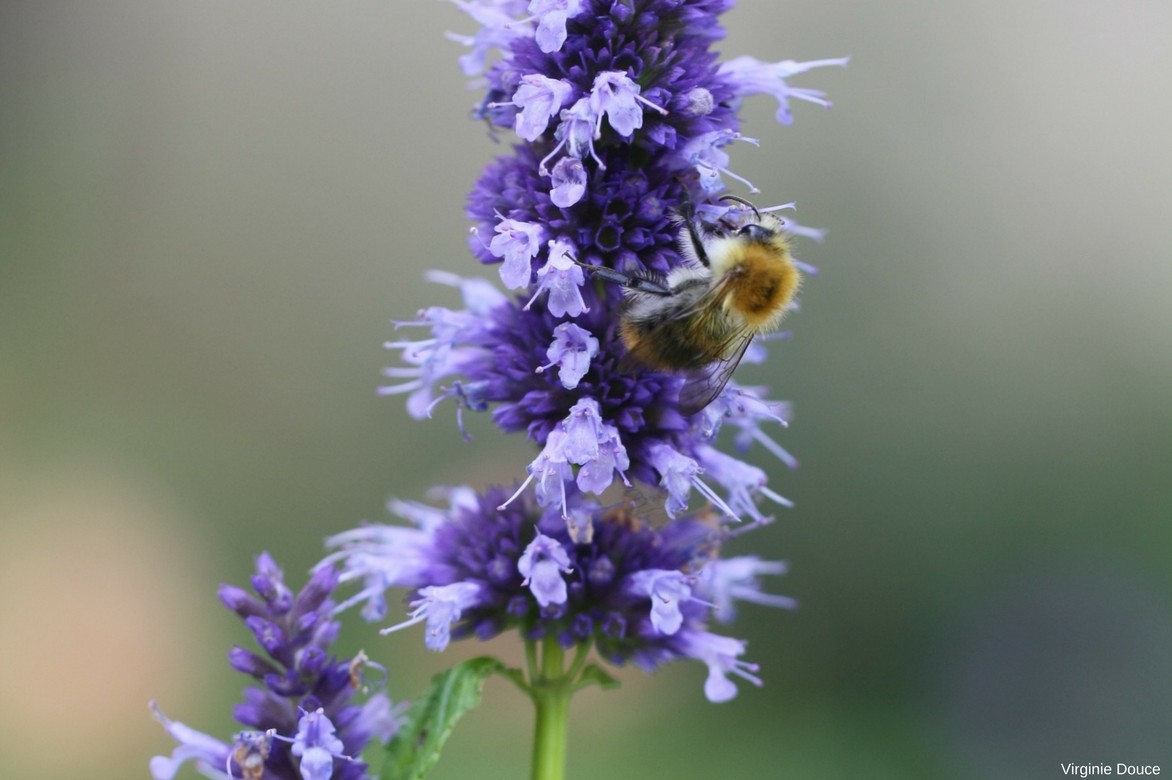
Agastache flowers are highly attractive to pollinators.
Hardy enough to thrive across France, agastache is a low-maintenance, easy-going plant that will delight all gardeners, even beginners. There’s just one key condition for its happiness: perfectly drained soil. It tolerates a wide range of soils, only struggling with heavy, clay-rich earth that becomes waterlogged in winter. It withstands both drought and cold and is untroubled by pests or diseases. Even if powdery mildew appears during the hottest, driest summers, it has no harmful effects.
Though agastache has a relatively short lifespan for a perennial (4-5 years), it makes up for this slight drawback with its abundant self-seeding, constantly offering new shoots at its base. Aromatic and vibrant, this long-overlooked perennial truly has all the qualities to earn a spot in your garden!
Description and botany
Botanical data
- Latin name Agastache
- Family Lamiacées
- Common name Agastache
- Flowering Estivale
- Height 0,30 à 1,50 m
- Sun exposure Soleil, mi-ombre
- Soil type Riche, frais, parfaitement drainé
- Hardiness -15°C
The agastache is an aromatic perennial whose flowering resembles lavender spikes. It actually belongs to the same family: Lamiaceae. The genus comprises around thirty species, originating from North America, Mexico, and also Asia (China and Japan), where it grows naturally in dry environments.
Highly ornamental, agastache has an upright, dense and bushy habit, ranging from 45 cm in height for the smallest varieties (Kudos series), to over 1.50 m for Agastache foeniculum ‘Golden Jubilee’ or anise hyssop.
The highly aromatic foliage emits, depending on the variety, a fragrance with notes of anise, liquorice, mint or lemon, much appreciated in cooking for flavouring dishes or in infusions. The deciduous leaves are simple, lanceolate, more or less triangular in shape, with finely toothed edges. Downy on the underside, they display shades ranging from medium green to deep green, not forgetting the luminous ‘Golden Jubilee’ with its golden foliage.
From this compact clump emerge upright spikes, composed of a multitude of small flowers in mauve, violet, pink, orange, red or even white, depending on the variety. This flowering, as vibrant as it is nectar-rich, attracts numerous pollinators, making it a valuable ally for biodiversity in our gardens. An advantage you can particularly benefit from by planting a few specimens in the vegetable garden.

Agastache comes in a beautiful range of colours: Agastache ‘Black Adder’ / Agastache ‘Kudos Gold’ / Agastache rugosa ‘Alabaster’ / Agastache ‘Kudos Coral’ / Agastache ‘Summer Sunset’.
More or less hardy, some species are sometimes grown as annuals, particularly Agastache foeniculum. They especially dislike heavy soils that retain water in winter. These perennials, however, adapt to all our climates, provided the soil is perfectly drained. Still, prefer a dry soil, even poor or chalky. Agastache, for example, thrives very well in rockeries. In clay soil, opt for planting Agastache rugosa, which is more tolerant.

Different types of foliage: Agastache ‘Golden Jubilee’ / Agastache ‘After Eight’ / Agastache mexicana ‘Red Fortune’ / Agastache rupestris / Agastache nepetoides.
In any case, and even though agastache tolerates partial shade, preferably plant it in full sun, where it will develop all its aromatic qualities and more abundant flowering. It will work wonders in borders or rockeries alongside other dry-soil plants. You can also take advantage of its wild appearance in flower meadows or on well-drained slopes. And if you don’t have a garden, agastache will also find its place in pots to adorn a well-exposed balcony!
Agastache is a perennial with a relatively short lifespan, between 4 and 5 years. However, it continually renews itself through self-seeding and divides very easily.
Discover agastache in video:
Read also
How to sow Agastache?Species and varieties
Agastache foeniculum, or Anise Hyssop, is one of the best-known species in the genus. Its ‘Golden Jubilee’ cultivar is particularly prized for its golden foliage.
Agastache rugosa also stands out for its greater tolerance to heavy soils and its wild appearance, which works wonders in natural gardens.
Other species exist, but you’ll generally find hybrid varieties in commerce, often with unspecified origins. Whatever your choice, remember to plant your agastaches in well-drained soil so they can thrive fully.
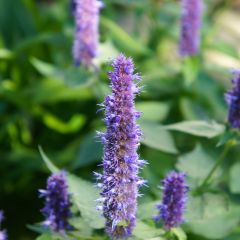
Agastache foeniculum Blackadder
- Période de floraison July to October
- Hauteur à maturité 80 cm
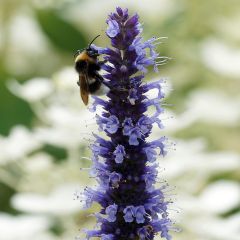
Agastache x rugosa Blue Fortune
- Période de floraison August to October
- Hauteur à maturité 80 cm
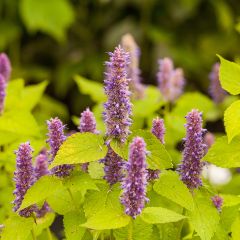
Agastache foeniculum Golden Jubilee
- Période de floraison August to October
- Hauteur à maturité 1,20 m

Agastache Kudos Coral
- Période de floraison July to October
- Hauteur à maturité 45 cm
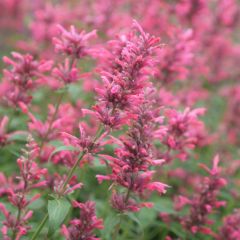
Agastache mexicana Red Fortune
- Période de floraison July to November
- Hauteur à maturité 1,20 m
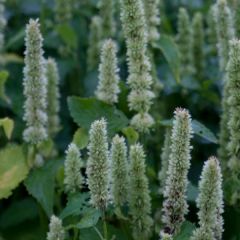
Agastache rugosa Alabaster
- Période de floraison July to October
- Hauteur à maturité 80 cm
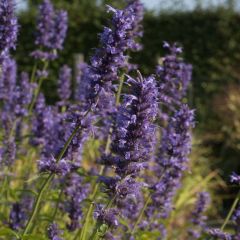
Agastache Serpentine
- Période de floraison August to October
- Hauteur à maturité 1,50 m
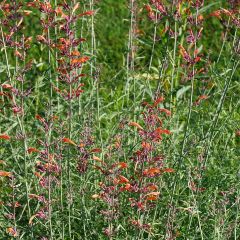
Agastache rupestris
- Période de floraison August to October
- Hauteur à maturité 60 cm
Planting Agastache
Where to plant it?
Hardy down to around -15°C and drought-resistant, agastache is an undemanding plant that thrives in all our climates.
It particularly enjoys rich, moist soils, but can flourish in any ordinary soil, even poor or chalky ones. For heavy, damp soils, we recommend Agastache rugosa, which adapts better to clay soils. Soil pH is largely unimportant, though it prefers neutral to chalky soils.
Whatever your soil type, it must be well-drained. While agastache can withstand drought (though at the expense of good flowering), it dislikes waterlogged soils. Excess moisture can even prove fatal in winter.
Choose a sunny spot to fully enjoy its aromatic qualities and abundant flowering. It will tolerate partial shade, however. In any case, protect it from cold winds by planting it against a sheltered wall, for example.
Agastache also grows well in pots, making it ideal for terraces or large balconies.
When to plant agastache?
Plant agastache in spring, from March to May, once the risk of frost has passed. Autumn planting in still-warm soil, between September and November, is also possible.
How to plant it?
In the ground:
- Prepare the soil by loosening it thoroughly.
- Add well-rotted compost, which will both enrich the soil and improve drainage.
- Dig a planting hole at least 3 times the size of the root ball.
- Place a layer of coarse gravel at the bottom of the hole to aid drainage. Avoid fine sand, which would have the opposite effect!
- Position the plant, ensuring the crown (where roots meet stem) is not buried.
- Backfill, firming the soil around the plant.
- Water immediately.
Space plants at 5 to 6 per square metre. Be mindful of larger varieties like ‘Serpentine’, which reaches 90cm in width when mature.
In pots:
- Choose a terracotta container with drainage holes.
- Add a layer of gravel or clay pebbles at the bottom to improve drainage.
- Plant in a mix of garden soil and well-rotted compost.
→ Learn more about Growing Agastache in Pots in Christine’s article
Read also
How to Take Cuttings from Agastache?Maintenance
Agastache is a very easy-going plant. In good growing conditions, with very well-drained soil, it may not even require any maintenance.
During spring (May-June), don’t hesitate to pinch back the tallest varieties to encourage bushier growth. Trim the tips of the stems by a few centimetres when they reach 15 to 25 cm in height. This pruning results in a denser habit and more abundant flowering.
You can deadhead spent flower spikes as needed to stimulate new blooms. If you wish to collect seeds or allow your agastache to self-seed, leave a few flower spikes in place.
Agastache is quite drought-tolerant, though regular watering benefits its flowering. However, for potted plants, water regularly to prevent the compost from drying out completely. Avoid waterlogging in saucers, as this can harm the plant.
Even when dry, agastache flower spikes remain highly decorative. Come autumn, you can leave them in place for a rustic display. Keeping the foliage over winter also helps protect the crown from frost. Wait until early spring to cut back the dried spikes and tidy the clump.
If you find agastache’s winter appearance unappealing, autumn pruning is an option. You might also gather a few spikes for dried arrangements. However, if cutting back severely (to about 5 cm above ground), mark the plant’s location clearly—winter passes, memories fade, and you might accidentally dig into the clump come spring!
Potted plants, being more vulnerable to frost, can be overwintered in a sheltered spot such as an unheated conservatory.
Agastache is a hardy perennial, resistant to both diseases and pests. Powdery mildew may affect foliage during hot, dry summers, though it’s rarely serious—simply trim affected parts.
Like all tender young shoots, agastache foliage may attract slugs in spring. No treatment is necessary; simply monitor until plants mature and become less appealing to gastropods. For severe infestations, use an organic-approved product like Ferramol.
Propagating Agastache: Sowing, Division and Cuttings
Agastache is a perennial with a relatively short lifespan (4-5 years on average) but it renews itself through self-seeding. You can also collect its seeds to sow them under cover, or propagate it by root division or semi-woody stem cuttings.
Sowing
Agastache seeds are easily collected from dried flower spikes. Store them in a dry, dark place over winter.
Sowing is best done from February to April under heated cover. The seeds germinate within a few weeks at temperatures between 15 and 20°C.
- Sow thinly in a seed tray using a special seed compost.
- Lightly cover the seeds with well-rotted compost or vermiculite.
- Cover the tray with a transparent lid or a clear plastic bag for 30 to 90 days (germination period).
- Place the tray in a bright spot and keep the substrate moist.
- Prick out into individual pots when seedlings reach 5–10 cm in height.
- Place the pots in a cold frame.
- Once the risk of frost has passed, transplant the seedlings to their final position.
Note: If you grow several agastache species, the resulting seedlings may surprise you. Different species hybridise easily, so new plants may differ from the parent plant.
→ Also check out Christine’s tutorial: How to Sow Agastache?
Division
Agastache responds well to root division in spring, between March and April:
- Dig up the clump using a sharp spade.
- Divide it into several sections, again using your spade.
- Replant immediately and water thoroughly.
Wait at least 2 years before dividing the new clumps again.
Cuttings
Take semi-woody (still flexible) stem cuttings in August:
- Choose non-flowering stems from the current year.
- Cut the tips to obtain 15–20 cm cuttings.
- Remove the leaves, keeping only the top ones.
- Plant the cuttings in compost mixed with vermiculite.
- Moisten the substrate.
- Keep the cuttings outdoors over winter, protected from frost and direct sun, watering regularly.
- Transplant in spring once the risk of frost has passed.
→ Also check out Christine’s tutorial: How to Take Agastache Cuttings?
Combining Agastache in the Garden
The slightly wild appearance of agastache makes it ideal for natural gardens, perfect for creating beautiful rockeries. Sedum is an excellent companion here, perfectly suited to dry soils. Choose a white variety to highlight the colour of your agastache spikes.
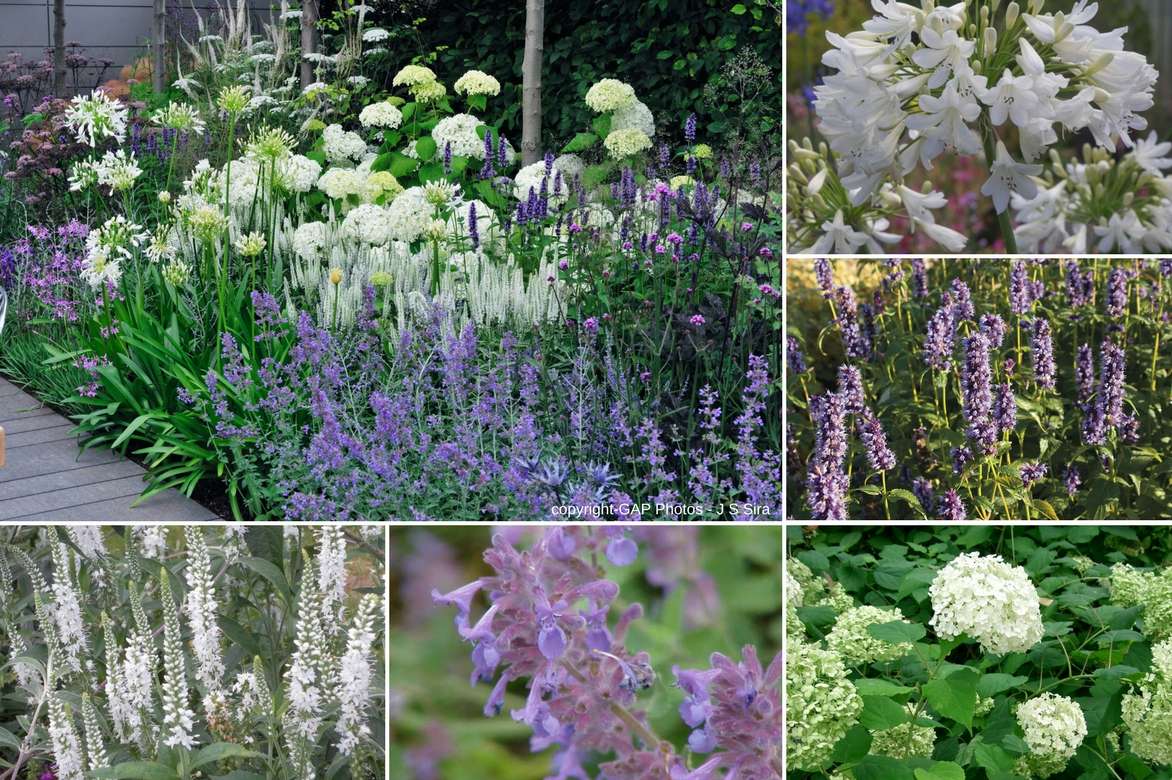
A blue and white planting idea: Agapanthus ‘Polar Ice’ / Agastache ‘Black Adder’ / Hydrangea arborescens ‘Annabelle’ / Nepeta mussinii / Veronica spicata ‘Alba’.
In flowerbeds, alternate agastache with other plants that have a wild, meadow-like appearance, such as cosmos, rudbeckias, or small ornamental grasses like blue oat grass (Helictotrichon sempervirens). Space plants about 80 cm apart to allow them to flourish fully.
Agastache is also perfect for creating borders, for example along a south-facing wall, where it will also be sheltered from cold winds. Pair the purple-pink of Agastache Kudos ‘Silver Blue’ with the steely blue globes of Echinops ritro and the soft pink of Phlox paniculata ‘Rosa Pastel’. Place a Stachys byzantina ‘Big Ears’ in the foreground, where its fuzzy grey foliage will beautifully enhance the colours of your composition.
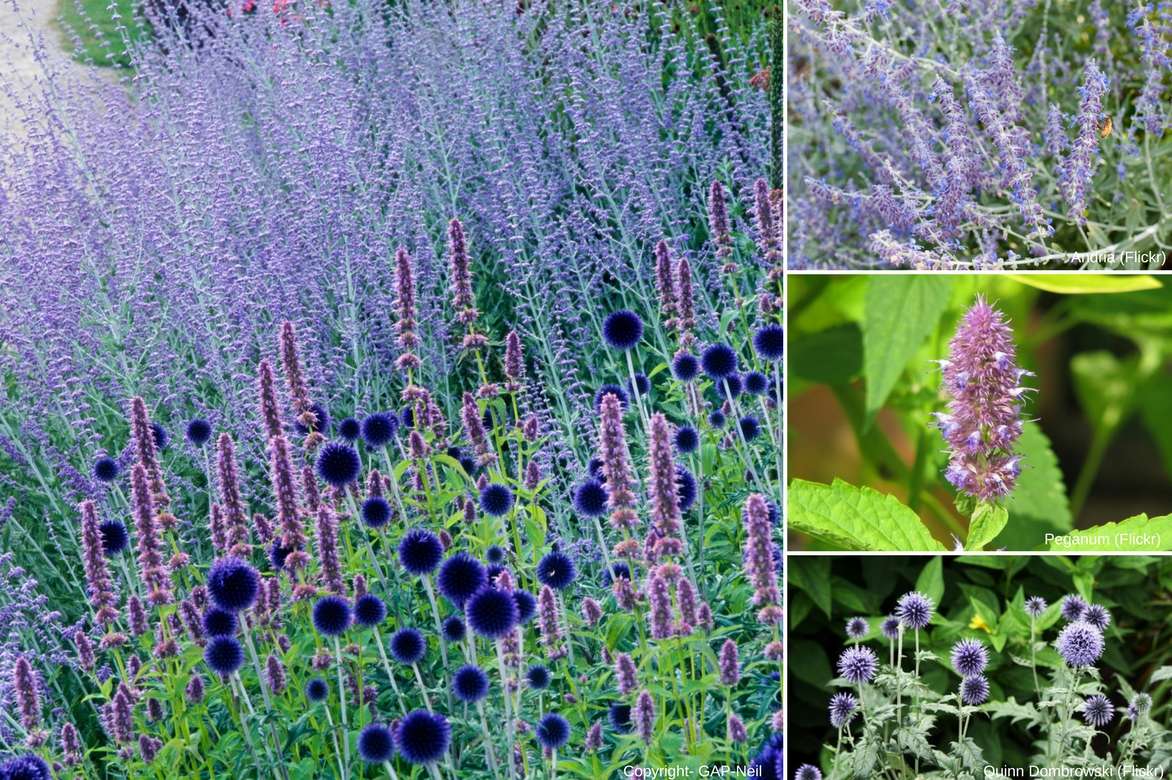
A lovely planting combination: Echinops ritro ‘Veitch’s Blue’ / Agastache rugosa ‘Golden Jubilee’ / Perovskia atriplicifolia ‘Blue Spire’.
For a more vibrant display, use warm tones that will elegantly contrast with the lavender-blue spikes of Agastache ‘Serpentine’. Heliopsis, helianthus, or rudbeckias are excellent choices for this. Add height to your composition with the tall umbels of agapanthus, which can reach up to 1m in height.
Agastache works beautifully in wildflower meadows or mixed borders, paired with nepeta or gaura. Stipa grasses will add an extra touch of wild, natural charm to this floral display.
The more compact varieties, particularly those in the Kudos series (rarely exceeding 45cm in height), can be grown in pots or containers to brighten up a sunny balcony. They look wonderful on their own or combined with trailing plants like petunias or ivy-leaved geraniums.
On a terrace, don’t hesitate to use taller varieties, which will form a lovely clump and enhance the space beautifully. Choose a terracotta pot, wide enough (at least 30–50cm in diameter) to allow your agastache to thrive.
Need a little extra inspiration? Discover our article: Agastache: 7 Successful Planting Combinations!
Did you know?
The name agastache comes from the Greek “aga”, meaning abundance, and “stachys”, meaning spike.
Useful resources
- Fall in love with one of our agastache varieties!
- Olivier introduces you to Agastache in video
- Find out more about edible plants and leaves you can cook with
Frequently asked questions
-
My agastache plants haven't come back this spring, why is that and what should I do?
The main enemy of agastache is overly wet soil in winter. Consider adding a layer of gravel during planting to improve drainage. When winter comes, do not cut back the faded aerial parts, as they help protect the crown from frost. Avoid mulching, or regularly aerate your mulch during dry weather. Waterlogged mulch would be harmful to your agastache.
-
I sowed Agastache seeds directly in the ground in spring, but none have germinated. Can you help?
Slugs, which are voracious for young shoots, and unfavourable weather conditions (heavy rain, late frost) make direct sowing in the ground tricky. Instead, try sowing in trays under cover. Seeds germinate better at temperatures around 20°C. Wait until the seedlings develop and transplant them into pots to help them grow stronger. Plant them out permanently once they are well-established, in warm, well-drained soil.
- Subscribe!
- Contents
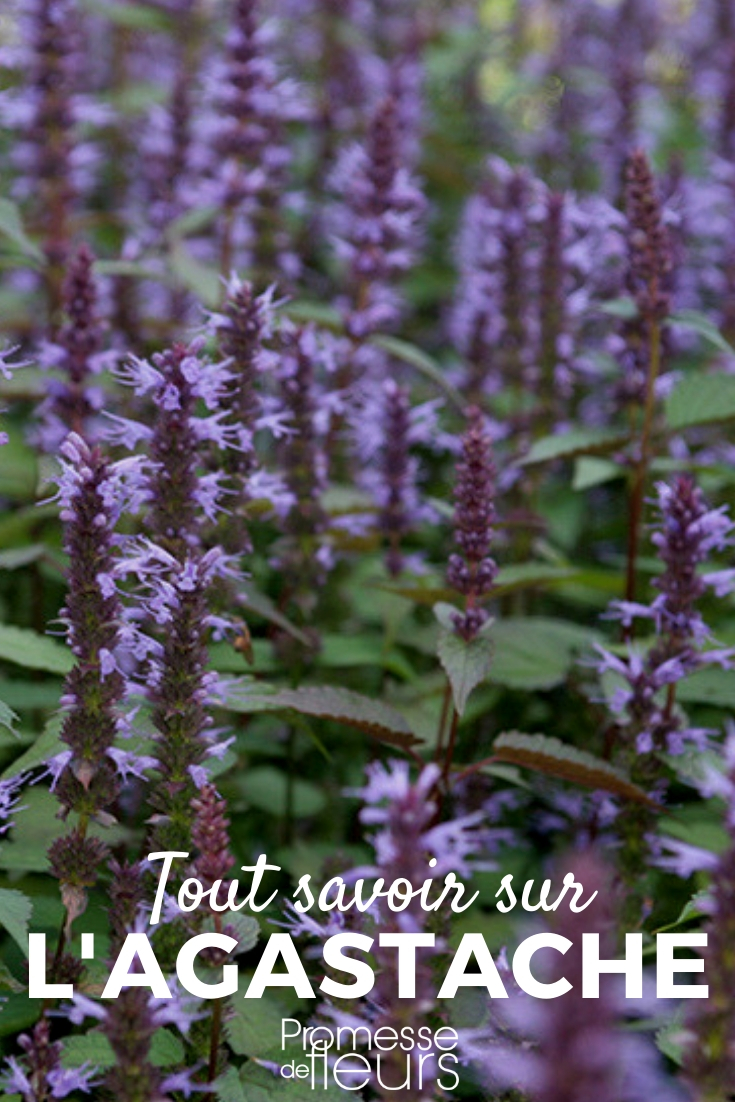


































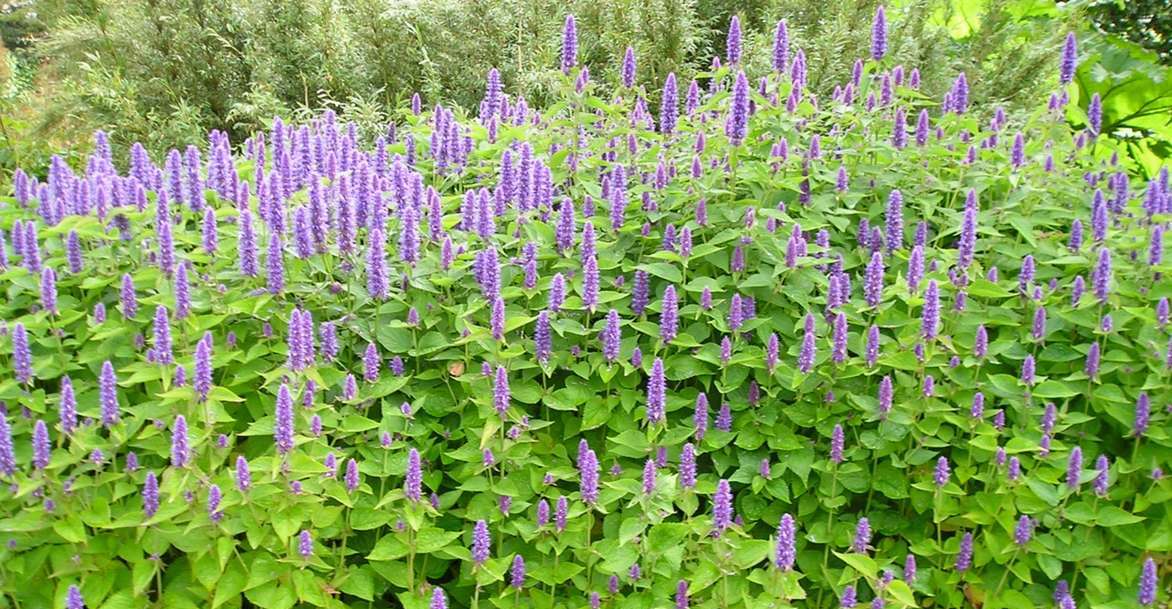

Comments